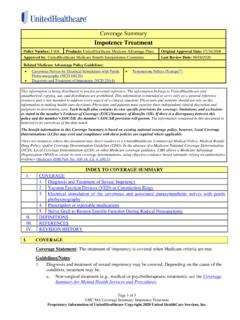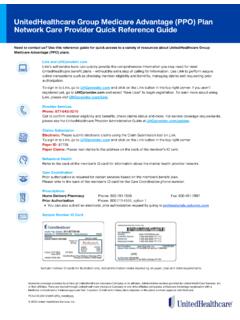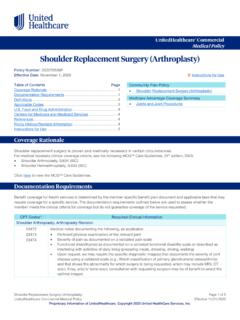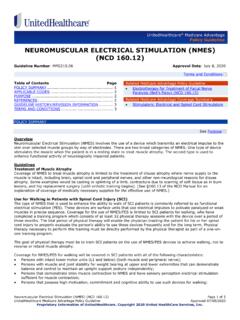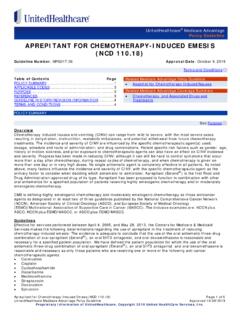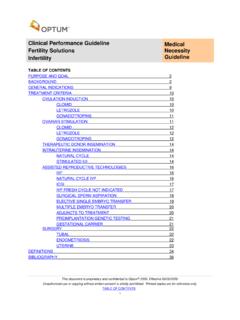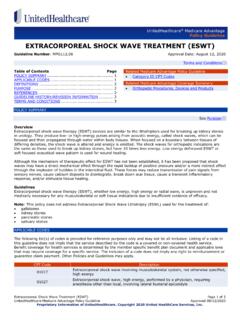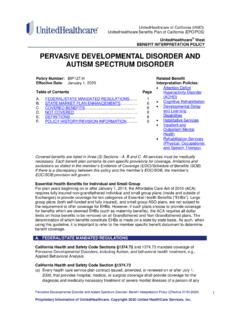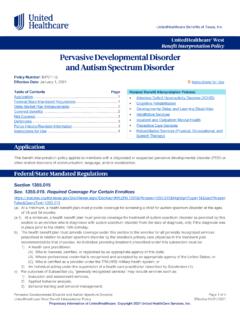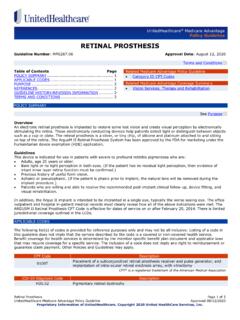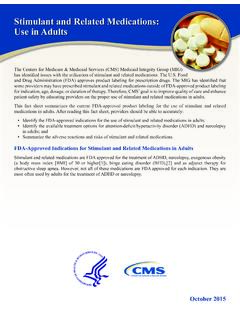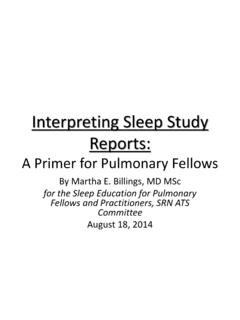Transcription of Bariatric Surgery – Commercial Medical Policy
1 Bariatric Surgery Page 1 of 65 UnitedHealthcare Commercial Medical Policy Effective 12/01/2020 Proprietary Information of UnitedHealthcare. Copyright 2020 United HealthCare Services, Inc. UnitedHealthcare Commercial Medica l Policy Bariatric Surgery Policy Number: 2020T0362FF Effective Date: December 1, 2020 Instructions for Use Table of Contents Page Coverage Rationale .. 1 Documentation Requirements .. 2 Definitions .. 3 Applicable Codes .. 4 Description of Services .. 6 Benefit Considerations .. 9 Clinical Evidence .. 9 Food and Drug Administration .. 52 References .. 53 Policy History/Revision Information .. 64 Instructions for Use .. 65 Coverage Rationale See Benefit Considerations The following Bariatric surgical procedures are proven and medically necessary for treating obesity: Biliopancreatic bypass/ Biliopancreatic diversion with duodenal switch Gastric bypass (includes robotic-assisted gastric bypass) Laparoscopic adjustable gastric banding for individuals > 18 years of age.
2 Refer to the Food and Drug Administration (FDA) section for additional information Sleeve Gastrectomy (Vertical Sleeve Gastrectomy) Vertical banded gastroplasty In adults, Bariatric Surgery using one of the procedures identified above for treating obesity is proven and medically necessary when all of the following criteria are met: Class III obesity; or Class II obesity in the presence of one or more of the following co-morbidities: o Type 2 diabetes; or o Cardiovascular disease [ , stroke, myocardial infarction, poorly controlled hypertension (systolic blood pressure greater than 140 mm Hg or diastolic blood pressure 90 mm Hg or greater, despite pharmacotherapy)]; or o History of coronary artery disease with a surgical intervention such as coronary artery bypass or percutaneous transluminal coronary angioplasty; or o History of cardiomyopathy.
3 Or o obstructive sleep Apnea (OSA) confirmed on polysomnography with an AHI or RDI of >30 and The individual must also meet the following criteria: o Both of the following: Completion of a preoperative evaluation that includes a detailed weight history along with dietary and physical activity patterns; and Related Commercial Policies Minimally Invasive Procedures for Gastroesophageal Reflux Disease (GERD) and Achalasia obstructive sleep Apnea Treatment Robotic-Assisted Surgery Policy Community Plan Policy Bariatric Surgery Medicare Advantage Coverage Summary Obesity: Treatment of Obesity, Non-Surgical and Surgical ( Bariatric Surgery ) Bariatric Surgery Page 2 of 65 UnitedHealthcare Commercial Medical Policy Effective 12/01/2020 Proprietary Information of UnitedHealthcare.
4 Copyright 2020 United HealthCare Services, Inc. Psychosocial-behavioral evaluation by an individual who is professionally recognized as part of a behavioral health discipline to provide screening and identification of risk factors or potential postoperative challenges that may contribute to a poor postoperative outcome or o Participation in a multi-disciplinary surgical preparatory regimen In Adolescents, the Bariatric surgical procedures identified above are proven and medically necessary for treating obesity when all of the following criteria are met: Class III obesity; or Class II obesity in the presence of one or more of the following co-morbidities: o Type 2 diabetes.
5 Or o Cardiovascular disease [ , stroke, myocardial infarction, poorly controlled hypertension (systolic blood pressure greater than 140 mm Hg or diastolic blood pressure 90 mm Hg or greater, despite pharmacotherapy)]; or o History of coronary artery disease with a surgical intervention such as coronary artery bypass or percutaneous transluminal coronary angioplasty; or o History of cardiomyopathy; or o obstructive sleep Apnea confirmed on polysomnography with an AHI or RDI of >30 and The individual must also receive an evaluation at, or in consultation with, a multidisciplinary center focused on the surgical treatment of severe childhood obesity. This may include adolescent centers that have received accreditation by the Metabolic and Bariatric Surgery Accreditation and Quality Improvement Program (MBSAQIP) or can demonstrate similar programmatic components.
6 Revisional Bariatric Surgery using one of the procedures identified above is proven and medically necessary when due to a Technical Failure or Major Complication from the initial Bariatric procedure. The following procedures are unproven and not medically necessary for treating obesity due to insufficient evidence of efficacy: Revisional Bariatric Surgery for any other indication than those listed above Bariatric Surgery as the primary treatment for any condition other than obesity Bariatric surgical interventions for the treatment of obesity including but not limited to: o Bariatric artery embolization (BAE) o Gastric electrical stimulation with an implantable gastric stimulator (IGS) o Intragastric balloon o Laparoscopic greater curvature plication, also known as total gastric vertical plication o Mini-gastric bypass (MGB)/Laparoscopic mini-gastric bypass (LMGBP) o Single-Anastomosis Duodenal Switch (also known as duodenal switch with single anastomosis, or stomach intestinal pylorus sparing Surgery [SIPS]) o Stomach aspiration therapy (AspireAssist ) o Transoral endoscopic Surgery (includes TransPyloric Shuttle (TPS ) Device) o Vagus Nerve Blocking (VBLOC ) Gastrointestinal liners (EndoBarrier )
7 Are investigational, unproven and not medically necessary for treating obesity due to lack of Food and Drug Administration (FDA) approval, and insufficient evidence of efficacy. Documentation Requirements Benefit coverage for health services is determined by the member specific benefit plan document and applicable laws that may require coverage for a specific service. The documentation requirements outlined below are used to assess whether the member meets the clinical criteria for coverage but do not guarantee coverage of the service requested. Bariatric Surgery Page 3 of 65 UnitedHealthcare Commercial Medical Policy Effective 12/01/2020 Proprietary Information of UnitedHealthcare.
8 Copyright 2020 United HealthCare Services, Inc. CPT Codes* Required Clinical Information Bariatric Surgery 0312T, 0313T, 0314T, 0315T, 0316T, 0317T, 43644, 43645, 43647, 43648, 43659, 43770, 43771, 43772, 43773, 43774, 43775, 43842, 43843, 43845, 43846, 43847, 43848, 43881, 43882, 43886, 43887, 43888, 64590, 64595, Medical notes documenting all of the following: Height Weight Current and five year history of BMI (body mass index) Diet history Co-morbidities Medical treatment tried and failed including diet and exercise Psychological evaluation by a licensed behavioral health professional Nutritional consult Name of the facility where the procedure will be performed Subsequent Bariatric Surgery 43860 43865 Medical notes documenting all of the following.
9 Height Weight BMI (body mass index) Diet history Co-morbidities Previous unsuccessful Medical treatment Name of the facility where the procedure will be performed Initial Bariatric Surgery performed and date and subsequent complications that require further surgical intervention *For code descriptions, see the Applicable Codes section. Definitions Adolescent: Individuals 12-21 years of age (Hardin and Hackell [American Academy of Pediatrics], 2017). For the purposes of this Policy , adults are considered >18 years of age. Body Mass Index (BMI): A person's weight in kilograms divided by the square of height in meters. BMI can be used as a screening tool but is not diagnostic of the body fatness or health of an individual (Centers for Disease Control and Prevention [CDC], 2017).
10 The National Heart, Lung and Blood Institute (NHLBI) (Jensen et al., 2013) classifies the ranges of BMI in adults as follows: < - Underweight to kg/m2 Normal Weight kg/m2 Overweight kg/m2 Obesity Class I kg/m2 Obesity Class II > 40 kg/m2 Extreme Obesity Class III The American Society of Metabolic and Bariatric Surgeons (ASMBS; Pratt et al., 2018), classifies severe obesity in adolescents as follows: Class II obesity 120% of the 95th percentile height, or an absolute BMI of kg/m2, whichever is lower* Class III obesity 140% of the 95th percentile height, or an absolute BMI of >40 kg/m2, whichever is lower *Also as defined by the American Heart Association (Kelly et al.)
